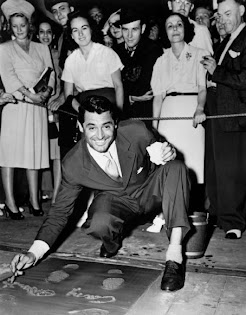If it wasn't for the pesky bobby pin that disappeared on the bathroom floor and forced me to a hands and knees position, I never would have noticed the resemblance the off-white tiles and gray grout have to Saul Bass's thick artistic tendencies. Admittedly, I don't know much about design. Admittedly, I don't really know what to say about Saul Bass's beautifully simple, sometimes stark to an uncomfortable degree, movie posters and titles of the 1950s and 60s, when movie posters/titles and art began to merge for the first time and shed the world of pulp (appropriately enough, at the same time the old studio system was losing its hold over movies and their approved subject matter). No, I really don't know what to say that probably hasn't already been said as far as art and expression and visual culture, except that Saul Bass was as much a part of the awakening '50s as any movie director.
The film that convinces me of this fact is The Man With the Golden Arm (1955), the movie that caused Otto Preminger to say "fuck it" and give us the first picture publicly unapproved by the industry and welcomed with open arms by a post-war movie public that was fed up with all the sugarcoating. The fact that it stars Frank Sinatra as a heroin addict, the all-American crooner, is another score for the gritty loving realists. The fact that he is nothing short of groundbreaking in the role of the struggling drummer and card dealer is icing on the cake.
The Man With the Golden Arm was made 10 years before The Sound of Music, but, like many movie lovers, I'm sure I'm not alone in associating Eleanor Parker with the perfectly coiffed Viennese baroness who nearly ruined things for Maria. How silly of us all, for it was Eleanor Parker who played a single working woman way back in 1944's One for the Book/ The Voice of the Turtle (it was not the more conventional, yet admittedly adorable elopement with Ronald Reagan at the end, but that spacious apartment she rented on her own, a rare occurrence in a pre-1950s film when wartime housing was often portrayed as patriotically shared, that appealed to a teenager ready to leave the nest). It was Eleanor Parker who endured prison life in the noir-esque Caged (1950), had an abortion behind her husband's back in Detective Story (1951), and suffered from abusive-resulting multiple personality disorder in Lizzie (1957). Ms. Parker was not partial to frou-frou roles, and even the slightly dark yet vulnerable undertones she gives off as Baroness Schraeder are evidence of this. So we really should have known, should have been completely aware of her ability to nail the pathetically fragile and deceitful wife of a drug addict to the falsely sacrificial cross. How appropriate that this luminous beaut with the breathy voice play such a role opposite Kim Novak's bosomy and supportive mistress. I can't help but think of Ingrid Bergman's barmaid Ivy knocking Lana Turner's Jekyll and Hyde good girl for a loop. She smartly fought for the role switch. She understood. And so did Parker. Of course, Parker's desperation, her paralyzing fear of loneliness and desertion make her a much more dangerous woman than fun-loving Ivy. And when she's found out at the end, when her treachery is naked and exposed, she plays it like a caged animal being taunted and poked by sticks, no longer the deceitful wife who quite literally drove her husband to the needle. She shrinks from taloned lioness to terrified kitten in a matter of seconds, and it is quite a thing to watch.
The guilt, destruction, and fear oozing out of the film's performances (all top-notch) are validated by Saul Bass's title design. The first time his thick lines and jagged fingers appear to Elmer Bernstein's equally superb jazz soundtrack you know you are in for something dark, and hard, and deliciously new--the rawness of what this must have felt like to a 1955 audience has hardly aged with time, because I felt it too. The golden arm reference is two-fold: the arm of shooting up, and the arm of Frankie Machine's card dealing talents. Pulled in competing directions, Frankie is at once trying to withstand Zosch's whistle announcing guilt trips, avoid his dealer's persuasive (and creepy) promises of peace and comfort, land a job as a drummer sans shaky hands, and, ultimately, reject all of the destructive callings of his previous life while living in the same town and cavorting with the same crowd that continues to use and abuse him. He is broken, and crooked, and reaching out. The only periods of true peace and comfort he achieves are with Molly, equally broken and struggling--Novak makes it seem as if every high-heeled step Molly takes is steeped in hopelessness, and yet Frankie's well-being is a hopeless task she'll willingly fight for, so he fights for it too. The hard-to-watch cold turkey scene is proof enough of this.
Bass went on to create posters and titles for Preminger's Anatomy of a Murder, Hitchcock's Vertigo, Psycho, and North By Northwest, It's a Mad Mad Mad Mad World, and a slew of others you can peruse here. You can also see how new DVD releases are butchering Bass's talent here (if you, you know, want to be a little depressed by the state of marketing). But it was really Golden Arm that started it all, that announced a change in both movies and audiences, and that utilized fabulously inseparable artwork that still inspires today in the titles of Catch Me If You Can, Burn After Reading, and even the animated recesses of Monsters, Inc. Who would have thought an arm cut out of paper could work such wonders?
Wednesday, June 15, 2011
Subscribe to:
Post Comments (Atom)














No comments:
Post a Comment